Council Of Europe
 From Nwe
From Nwe 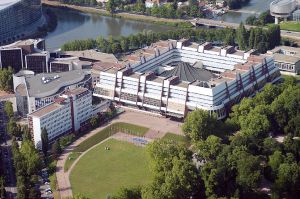
The Council of Europe is the oldest international organization working towards European integration, having been founded in 1949. It has a particular emphasis on legal standards, human rights, democratic development, the rule of law, and cultural cooperation. It has 47 member states with some 800 million citizens. Its statutory institutions are the Committee of Ministers comprising the foreign ministers of each member state, the Parliamentary Assembly composed of MPs from the Parliament of each member state, and the Secretary General heading the secretariat of the Council of Europe. The seat of the Council of Europe is in Strasbourg, France and English and French are its two official languages. The Committee of Ministers and the Parliamentary Assembly also work in German, Italian and Russian.
The most famous bodies of the Council of Europe are the European Court of Human Rights which enforces the European Convention on Human Rights and the European Pharmacopoeia Commission which sets the quality standards for pharmaceutical products in Europe. The Council of Europe's work has resulted in standards, charters and conventions to facilitate cooperation between European countries and further integration. The vision behind the founding of the post World War II European institutions which resulted in founding of the Council of Europe was to bring about a fundamental change in the way people think and act, so that global solidarity and respect for rights and for human dignity would become automatic, scarcely in need of legal protection at all. Until such a change in the generic code of humanity occurs, the Council through its conventions and charters works to standardize practice and to encourage its members to make war unthinkable and peace a global reality.
History
In 1945, at the end of the second World War, Europe was marked by unprecedented devastation and human suffering. It faced new political challenges, in particular reconciliation among the peoples of Europe. This situation favored the long held idea of European integration through the creation of common institutions.
While at present the Council of Europe and the European Union are separate organizations they share both founding fathers and a founding vision. Both organizations aim to promote European solidarity, peace, and prosperity. Both placed human rights at the center. Both set out to make war unthinkable; both adopted as "their watchword a maxim created by Count Richard Coudenhove-Kalegi between the wars, "A divided Europe leads to war, oppression and hardship; a united Europe leads to peace and prosperity."[1] Its founding membership, though, was larger than that of what became the EU, which began with six members. The Council of Europe began with ten. Signing the Treaty, Italian Foreign Minister, Count Carlo Sforzathe spoke about the Council as an instrument for peace and for the creation of mutual prosperity; "The more we will organize ourselves, the more we shall be prosperous; the more we shall be prosperous, the more we will understand that our supreme necessity is one and only one: PEACE."[2]
In his famous speech at the University of Zurich on September 19, 1946,[3] Sir Winston Churchill called for a United States of Europe and the creation of a Council of Europe. He had spoken of a Council of Europe as early as 1943 in a broadcast to the nation.[4] The future structure of the Council of Europe was discussed at a specific congress of several hundred leading politicians, government representatives and civil society in The Hague, Netherlands in 1948. There were two schools of thought competing: Some favored a classical international organization with representatives of governments, while others preferred a political forum with parliamentarians. Both approaches were finally combined through the creation of the Committee of Ministers and the Parliamentary Assembly under the Statute of the Council of Europe. This dual intergovernmental and inter-parliamentary structure was later copied for the European Communities, NATO and the OSCE.
The Council of Europe was founded on May 5, 1949, by the Treaty of London. The Treaty of London or the Statute of the Council of Europe was signed in London on that day by ten states: Belgium, Denmark, France, Ireland, Italy, Luxembourg, the Netherlands, Norway, Sweden, and the United Kingdom. Many states followed, especially after the democratic transitions in central and eastern Europe during the early 1990s, and the Council of Europe now integrates nearly all states of Europe.
Aims and achievements
Article 1(a) of the Statute states that "The aim of the Council of Europe is to achieve a greater unity between its members for the purpose of safeguarding and realizing the ideals and principles which are their common heritage and facilitating their economic and social progress." Therefore, membership is open to all European states which seek European integration, accept the principle of the rule of law and are able and willing to guarantee democracy, fundamental human rights, and freedoms.
While the member states of the European Union transfer national legislative and executive powers to the European Commission and the European Parliament in specific areas under European Community law, Council of Europe member states maintain their sovereignty but commit themselves through conventions (that is, public international law) and co-operate on the basis of common values and common political decisions. Those conventions and decisions are developed by the member states working together at the Council of Europe, whereas secondary European Community law is set by the organs of the European Union. Both organizations function as concentric circles around the common foundations for European integration, with the Council of Europe being the geographically wider circle. The European Union could be seen as the smaller circle with a much higher level of integration through the transfer of powers from the national to the EU level. Being part of public international law, Council of Europe conventions could also be opened for signature to non-member states thus facilitating equal co-operation with countries outside Europe (see chapter below).
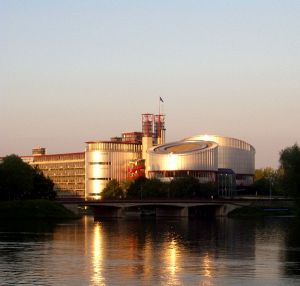
The Council of Europe's most famous achievement is the European Convention on Human Rights, which was adopted in 1950 following a report by the Council of Europe's Parliamentary Assembly. The Convention created the European Court of Human Rights in Strasbourg. The Court supervises compliance with the European Convention on Human Rights and thus functions as the highest European court for human rights and fundamental freedoms. It is to this court that Europeans can bring cases if they believe that a member country has violated their fundamental rights.
The wide activities and achievements of the Council of Europe can be found in detail on its official website. In a nutshell, the Council of Europe works in the following areas:
- Protection of the rule of law and fostering legal co-operation through some 200 conventions and other treaties, including such leading instruments as the Convention on Cybercrime, the Convention on the Prevention of Terrorism, the Conventions against Corruption and Organized Crime, and the Convention on Human Rights and Biomedecine.[5]
- CODEXTER, designed to co-ordinate counter-terrorism measures
- The European Commission for the Efficiency of Justice (CEPEJ)
- Protection of human rights, notably through:
- European Convention on Human Rights
- European Committee for the Prevention of Torture
- Convention on Action against Trafficking in Human Beings[6]
- Convention on the Protection of Children against Sexual Exploitation and Sexual Abuse[7]
- Social rights under the European Social Charter
- Linguistic rights under the European Charter for Regional or Minority Languages
- Minority rights under the Framework Convention for the Protection of National Minorities
- Media freedom under Article 10 of the European Convention on Human Rights and the European Convention on Transfrontier Television
- Protection of democracy through parliamentary scrutiny and election monitoring by its Parliamentary Assembly as well as assistance in democratic reforms, in particular by the Venice Commission.
- Promotion of cultural co-operation and diversity under the Council of Europe's Cultural Convention of 1954 and several conventions on the protection of cultural heritage as well as through its Centre for Modern Languages in Graz, Austria and its North-South Centre in Lisbon, Portugal.
- Promotion of the right to education under Article 2 of the first Protocol to the European Convention on Human Rights and several conventions on the recognition of university studies and diplomas (see also Bologna Process and Lisbon Recognition Convention).
- Promotion of fair sport through the Anti-Doping Convention[8] and the Convention against Spectator Violence.[9]
- Promotion of European youth exchanges and co-operation through European Youth Centers in Strasbourg and Budapest, Hungary.
- Promotion of the quality of medicines throughout Europe by the European Directorate for the Quality of Medicines and its European Pharmacopoeia.
Institutions
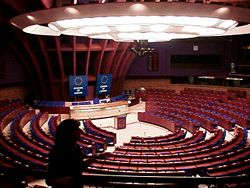
The institutions of the Council of Europe are:
- The Secretary General, who is elected for a term of five years by the Parliamentary Assembly and heads the Secretariat of the Council of Europe. Since 2004, Terry Davis from the United Kingdom has been Secretary General.
- The Committee of Ministers, comprising the Ministers of Foreign Affairs of all 47 member states who are represented by their Permanent Representatives and Ambassadors accredited to the Council of Europe. Committee of Ministers' presidencies are held in alphabetical order for six months following the English alphabet (Slovenia and Sweden changed their places due to the fact that Slovenia held the EU Presidency in 2008): Sweden 05/2008-11/2008, Spain 11/2008-05/2009, Slovenia 05/2009-11/2009, Switzerland 11/2009-05/2010, "the former Yugoslav Republic of Macedonia" 05/2010-11/2010, Turkey 11/2010-05/2011, and so on.
- The Parliamentary Assembly (PACE), which comprises national parliamentarians from all member states and elects its President for a year with the possibility of being re-elected for another year. In January 2008, Lluis Maria de Puig from Spain was elected President of the Parliamentary Assembly. National parliamentary delegations to the Assembly must reflect the political spectrum of their national parliament, i.e. comprise government and opposition parties. The Assembly appoints members as rapporteurs with the mandate to prepare parliamentary reports on specific subjects. The British MP Sir David Maxwell-Fyfe was rapporteur for the drafting of the European Convention on Human Rights. Dick Marty's reports on secret CIA detentions and rendition flights in Europe became quite famous in 2007. Other Assembly rapporteurs were instrumental in, for example, the abolition of the death penalty in Europe, the political and human rights situation in Chechnya, disappeared persons in Belarus, freedom of expression in the media and many other subjects.
- The Congress of the Council of Europe (Congress of Local and Regional Authorities of Europe), which was created in 1994 and comprises political representatives from local and regional authorities in all member states. The most influential instruments of the Council of Europe in this field are the European Charter of Local Self-Government of 1985 and the European Outline Convention on Transfrontier Co-operation between Territorial Communities or Authorities of 1980.
- The European Court of Human Rights, created under the European Convention on Human Rights of 1950, is composed of a judge from each member state elected for a renewable term of six years by the Parliamentary Assembly and is headed by the elected President of the Court. Since 2007, Jean-Paul Costa from France is the President of the Court. Under the new Protocol No. 14 to the European Convention on Human Rights, the terms of office of judges shall be nine years but non-renewable. All member states except Russia have signed and ratified Protocol No. 14.
- The Commissioner for Human Rights, who is elected by the Parliamentary Assembly for a non-renewable term of six years since the creation of this position in 1999. This position is held since 2006 by Thomas Hammarberg from Sweden.
- The NGOs (NGOs) can participate in the INGO Conference of the Council of Europe. Since the [Resolution (2003)8] adopted by the Committee of Ministers on 19 November 2003, they are given a “participatory status.”[10]
- Information Offices of the Council of Europe in many member states.
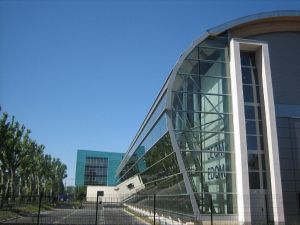
The CoE system also includes a number of semi-autonomous structures known as "Partial Agreements," some of which are also open to non-member states:
- The Council of Europe Development Bank in Paris
- The European Directorate for the Quality of Medicines with its European Pharmacopoeia
- The European Audiovisual Observatory
- The European Support Fund Eurimages for the co-production and distribution of films
- The Pompidou Group—Cooperation Group to Combat Drug Abuse and Illicit Trafficking in Drugs
- The European Commission for Democracy through Law, better known as the Venice Commission
- The Group of States Against Corruption (GRECO)
- The European and Mediterranean Major Hazards Agreement (EUR-OPA) which is a platform for co-operation between European and Southern Mediterranean countries in the field of major natural and technological disasters.
- The Enlarged Partial Agreement on Sport, which is open to accession by states and sport associations.[11]
- The North-South Centre of the Council of Europe in Lisbon (Portugal)
- The Center for Modern Languages is in Graz (Austria)
Headquarters and buildings
The seat of the Council of Europe is in Strasbourg, France. First meetings were held in Strasbourg's University Palace in 1949, but the Council of Europe moved soon into its own buildings. The Council of Europe's eight main buildings are situated in the Quartier européen, an area in the north-west of Strasbourg spread over the three districts Le Wacken, La Robertsau and Quartier de l'Orangerie, that also features the four buildings of the seat of the European Parliament in Strasbourg, the Arte headquarters and the seat of the International Institute of Human Rights.
Building in the area started in 1949 with the predecessor of the Palais de l'Europe, the House of Europe (torn down in 1977) and came to a provisional end in 2007 with the opening of the New General Office Building in 2008. The Palais de l'Europe (Palace of Europe) as well as the Art Nouveau Villa Schutzenberger (seat of the European Audiovisual Observatory) are located in the Orangerie district, the European Court of Human Rights, the European Directorate for the Quality of Medicines and the Agora Building are situated in the Robertsau district. The Agora building has been voted "best international business center real estate project of 2007" on March 13, 2008, at the MIPIM 2008. The European Youth Centre is located in the Wacken district.
Besides its headquarters in Strasbourg, the Council of Europe is also present in other cities and countries. The Council of Europe Development Bank has its seat in Paris, the North-South Centre of the Council of Europe is established in Lisbon, Portugal, and the Centre for Modern Languages is in Graz, Austria. There are European Youth Centers in Budapest, Hungary and Strasbourg. The new European Resource Centre on education for intercultural dialogue, human rights and democratic citizenship will be set up in Oslo, Norway, in autumn 2008.
The Council of Europe has offices in Albania, Armenia, Azerbaijan, Bosnia and Herzegovina, Georgia, Moldova, Montenegro, Serbia, Kosovo, Ukraine, and information offices in Albania, Armenia, Azerbaijan, Bulgaria, Czech Republic, Estonia, Georgia, Hungary, Latvia, Lithuania, Moldova, Poland, Romania, Russian Federation, Slovakia, Slovenia, "The former Yugoslav Republic of Macedonia," Ukraine, and a projects office in Turkey.
Symbols
The Council of Europe created and uses as its official symbols the famous European Flag with 12 golden stars arranged in a circle on a blue background since 1955, and the European anthem based on the Ode to Joy in the final movement of Ludwig van Beethoven's Ninth symphony since 1972.
On May 5, 1964, the 15th anniversary of its founding, the Council of Europe established May 5 as Europe Day.[12]
Although protected by copyright, the wide private and public use of the European Flag is encouraged to symbolize a European dimension. To avoid confusion with the European Union which subsequently adopted the same flag in the 1980s, as well as other European institutions, the Council of Europe often uses a modified version with a lower-case "e" in the center of the stars which is referred to as the "Council of Europe Logo".[13][12]
Membership
The Council of Europe was founded on 1949-05-05 by Belgium, Denmark, France, Ireland, Italy, Luxembourg, Netherlands, Norway, Sweden and the United Kingdom. It now has 47 member states, with Montenegro being the latest to join. Some members have some or most of their territory extending beyond Europe, and in the case of Armenia and Cyprus, they are located entirely outside Europe; these states are included due to their historical and cultural links to Europe.
As a result, nearly all European states have acceded to the Council, with the exception of Belarus (dictatorship), Kazakhstan (dictatorship), Kosovo (partly unrecognized), Abkhazia (recognized only by two countries), South Ossetia (recognized only by two countries), Northern Cyprus (recognized only by one country), Nagorno-Karabakh (unrecognized), Pridnestrovie (unrecognized), and the Holy See (unique status). The latter is, however, an observer.
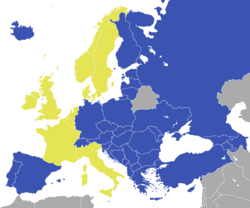
| Notes on table; aAlso considered as a founder of the organization. bIn 1950, the Federal Republic of Germany (West Germany), est. 23 May 1949, and then French-occupied Saar (protectorate) became associate members. (West) Germany became a full member in 1951, while the Saarland withdrew from its associate membership in 1956 after acceding to the Federal Republic after a referendum in 1955. The Soviet-occupied eastern part of Germany and later East German Democratic Republic never became a member of the Council of Europe. Through German reunification in 1990, the five Länder (i.e. states/regions) of East Germany acceded to the Federal Republic of Germany and thus gained representation in the Council of Europe. |
| Flag | State | Date joined |
|---|---|---|
| Belgium | Founder | |
| Denmark | Founder | |
| France | Founder | |
| Ireland | Founder | |
| Italy | Founder | |
| Luxembourg | Founder | |
| Netherlands | Founder | |
| Norway | Founder | |
| Sweden | Founder | |
| United Kingdom | Founder | |
| Greecea | 1949-08-09 | |
| Turkeya | 1949-08-09 | |
| Iceland | 1950-03-07 | |
| Germanyb | 1950-07-13 | |
| Austria | 1956-04-16 | |
| Cyprus | 1961-05-24 | |
| Switzerland | 1963-05-06 | |
| Malta | 1965-04-29 | |
| Portugal | 1976-09-22 | |
| Spain | 1977-11-24 | |
| Liechtenstein | 1978-11-23 | |
| San Marino | 1988-11-16 | |
| Finland | 1989-05-05 | |
| Hungary | 1990-11-06 | |
| Poland | 1991-11-26 | |
| Bulgaria | 1992-05-07 | |
| Estonia | 1993-05-14 | |
| Lithuania | 1993-05-14 | |
| Slovenia | 1993-05-14 | |
| Czech Republic | 1993-06-30 | |
| Slovakia | 1993-06-30 | |
| Romania | 1993-10-07 | |
| Andorra | 1994-11-10 | |
| Latvia | 1995-02-10 | |
| Albania | 1995-07-13 | |
| Moldova | 1995-07-13 | |
| FYR Macedoniac | 1995-11-09 | |
| Ukraine | 1995-11-09 | |
| Russia | 1996-02-28 | |
| Croatia | 1996-11-06 | |
| Georgia | 1999-04-27 | |
| Armenia | 2001-01-25 | |
| Azerbaijan | 2001-01-25 | |
| Bosnia and Herzegovina | 2002-04-24 | |
| Serbiad | 2003-04-03 | |
| Monaco | 2004-10-05 | |
| Montenegro | 2007-05-11 |
Following its declaration of independence on 3 June 2006, Montenegro submitted a request to accede to the Council of Europe. The Committee of Ministers transmitted the request to the Parliamentary Assembly for opinion, in accordance with the usual procedure. Eleven days later, on 14 June 2006, the Committee of Ministers declared that the Republic of Serbia would continue the membership of the State Union of Serbia and Montenegro.[15] On 11 May 2007, Montenegro joined the Council of Europe as 47th member state.
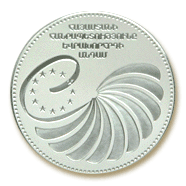
Applicants
The Parliament of Belarus held special guest status with the Parliamentary Assembly from September 1992 to January 1997, but this has been suspended as a consequence of the November 1996 constitutional referendum and parliament by-elections which the CoE found to be undemocratic, as well as limits on democratic freedoms such as freedom of expression (cf. Belarusian media) under the authoritarian regime of President Alexander Lukashenko. The constitution changed by the referendum "does not respect minimum democratic standards and violates the principles of separation of powers and the rule of law.[16] Belarus applied for full membership on March 12 1993 (still open).
Kazakhstan applied for the Special Guest status with the Parliamentary Assembly in 1999. The Assembly found that Kazakhstan could apply for full membership, because it is partially located in Europe, but granting Special Guest status would require improvements in the fields of democracy and human rights. Kazakhstan signed a co-operation agreement with the Assembly.
Observers
Canada, Japan, Mexico, the U.S., and the Holy See have observer status with the Council of Europe and can participate in the Committee of Ministers and all intergovernmental committees. They may contribute financially to the activities of the Council of Europe on a voluntary basis.
The parliaments of Canada, Israel, Mexico and Morocco have observer status with the Parliamentary Assembly and their delegations can participate in Assembly sessions and committee meetings. Representatives of the Palestinian Legislative Council may participate in Assembly debates concerning the Middle East as well as Turkish representatives from Northern Cyprus concerning this island.
There has been criticism concerning the observer status of Japan and the US because both countries apply the death penalty.
Co-operation
Non-member states
The Council of Europe works mainly through conventions. By drafting conventions or international treaties, common legal standards are set for its member states. However, several conventions have also been opened for signature to non-member states. Important examples are the Convention on Cybercrime (signed, for example, by Canada, Japan, South Africa, and the United States), the Lisbon Recognition Convention on the recognition of study periods and degrees (signed e.g. by Australia, Belarus, Canada, the Holy See, Israel, Kazakhstan, Kyrgyzstan, and the U.S.), the Anti-doping Convention (signed e.g. by Australia, Belarus, Canada, and Tunisia) and the Convention on the Conservation of European Wildlife and Natural Habitats (signed e.g. by Burkina Faso, Morocco, Tunisia and Senegal as well as the European Community). Non-member states also participate in several partial agreements, such as the Venice Commission, the Group of States Against Corruption GRECO and the European Pharmacopoeia Commission.
European Union
Relations in general between the CoE and the EU
As mentioned in the introduction, it is important to realize that the Council of Europe is not to be mistaken with the Council of the European Union or the European Council. These belong to the European Union, which is separate from the Council of Europe, although they have shared the same European flag and anthem since the 1980s because they also work for European integration.
Cooperation between the European Union and the Council of Europe has recently been reinforced, notably on culture and education as well as on the international enforcement of justice and Human Rights.[17]
The European Union is expected to accede to the European Convention on Human Rights (the Convention). At their Warsaw Summit in 2005, the Heads of State and Government of all Council of Europe member states reiterated their desire for the EU to accede without delay to ensure consistent human rights protection across Europe. There are also concerns about consistency in case law - the European Court of Justice (the EU's court in Luxembourg) is treating the Convention as part of the legal system of all EU member states in order to prevent conflict between its judgments and those of the European Court of Human Rights (the court in Strasbourg interpreting the Convention). Protocol No.14 of the Convention is designed to allow the EU to accede to it and the EU Reform Treaty contains a protocol binding the EU to join. The EU would thus be subject to its human rights law and external monitoring as its member states currently are. It is further proposed that the EU join as a member of the Council of Europe once it has attained its legal personality in the Reform Treaty, possibly in 2010.[1]
Joint Programs between the CoE and the EU
The Council of Europe and the European Union are based on the same values and pursue common aims with regard to the protection of democracy, respect for human rights and fundamental freedoms and the rule of law. These common aims have led the Council of Europe and the European Union to develop a very tight network of relations and cooperation links (participation of the European Commission to meet Council of Europe activities, accession of European Union to Council of Europe Conventions, and so on). One significant instrument of this cooperation is the conclusion since 1993 of a number of joint programs, for essentially cooperation with countries which have joined the Council of Europe since 1989. The same countries have developed increasingly close links with the European Union, or have applied for membership. By combining forces in this way, the complementarity of respective activities of the European Commission and the Council of Europe has been enhanced. In April 2001, an important step was taken through the signature by the European Commission and the Council of Europe of a Joint Declaration on Cooperation and Partnership, which, among other things, offers more systematic means of joint programming and priority-setting.[18]
Country-specific and thematic Joint Programs
Most joint programs are country-specific. They cover Albania (since 1993), Ukraine (since 1995), the Russian Federation (since 1996), Moldova (since 1997), Georgia (since 1999), Serbia, Montenegro, Armenia,and Azerbaijan (since 2001), Turkey (since 2001), Bosnia and Herzegovina (since 2003) and also "the Former Yugoslav Republic of Macedonia." Other Joint Programs, for instance for the Baltic States (Estonia, Latvia and Lithuania) have also been implemented in the past. There have also been multilateral thematic joint programs, open to Central and Eastern European countries, regarding, for instance, national minorities, the fight against organized crime and corruption, and the development of independent and multidisciplinary ethics committees for review of biomedical research. There have been other multilateral joint programs, for awareness-raising on the abolition of the death penalty, the preparation of the European conference to fight against racism and intolerance, action to promote the European Social Charter and a program to strengthen democracy and constitutional development in central and eastern Europe with the Council of Europe's Venice Commission.
There is a "Council of Europe Project Office" in Ankara, Turkey since 2004 which implements joint projects of the Council of Europe and the European Union in co-operation with the Turkish government.
Activities
The Joint Programs consist of a series of activities agreed between the European Commission and the Council of Europe, in consultation with the governments of the concerned countries, designed to facilitate and support legal and institutional reform. Training courses, expert reports and advice to governments, conferences, workshops, seminars and publication dissemination are all usual working methods. The emphasis has been on training and advice but in some cases Joint Programs have even offered limited material support (for instance with the establishment of the Albanian School of Magistrates and the State Publications Centre).
Programming and funding
The Directorate General for External Relations of the European Commission and the Council of Europe's Directorate of Strategic Planning (as well as other services as applicable) set and match priorities for the purpose of Joint Programs. Sometimes the Council of Europe makes proposals to the European Commission for urgent joint undertakings. EuropeAid is the structure within the European Commission involved in the final selection and administrative follow-up of programs. The Council of Europe counterpart throughout the project cycle is the Directorate of Strategic Planning, in close consultation with the different Council of Europe Directorates General responsible for the implementation of the activities. In recent years the European Commission Delegations in the beneficiary countries have increasingly been implied in the Joint Programs. Equally, Council of Europe Secretariat Offices in the field support planning and implementation.
The European Commission and the Council of Europe provide joint funding for the program, and the Council of Europe is responsible for its implementation. In most cases funding is shared on a 50-50 basis but on some occasions the European Commission has contributed with proportionally more resources. A large number of Joint Programs have been concluded with the EC's European Initiative for Democracy and Human Rights (EIDHR).
Programs have also been concluded with the European Commission's TACIS and CARDS programs. In 2002 a major Joint Program for Turkey became operational, with resources from the EU enlargement funds and the Council of Europe. In 2001 two Joint Programs were established with the European Agency for Reconstruction (EAR), a decentralized agency of the European Union that deals with assistance to Serbia, Montenegro, Kosovo, and FYROM.
Program partners
The Council of Europe often works with partner institutions in the country concerned. Partners may include:
- The Ministries of Justice, Foreign Affairs and the Interior
- The national and regional Bar Associations
- The office of the Public Prosecutor
- The Courts and judicial training centers
- The national or regional commissioners on human rights
- Journalists' unions
- Other professional bodies
- Human rights protection movements and other non-governmental organizations.
United Nations
The Council of Europe holds observer status with the United Nations and is regularly represented in the UN General Assembly. It has organized the regional UN conferences against racism and on women and cooperates with the United Nations at many levels, in particular in the areas of human rights, minorities, migration and counter-terrorism.
Non-governmental Organizations
Non-governmental Organizations (NGOs) can participate in the INGO Conference of the Council of Europe and become observers to inter-governmental committees of experts. The Council of Europe drafted the European Convention on the Recognition of the Legal Personality of International Non-Governmental Organizations in 1986, which sets the legal basis for the existence and work of NGOs in Europe. Article 11 of the European Convention on Human Rights protects the right to freedom of association, which is also a fundamental norm for NGOs.
Future
From a founding membership of 10, the Council of Europe has grown to include 47 states stretching across the Cold War East-West divide. Committed to European solidarity, to raising living standards, protecting human right and ending conflict much of the work of the Council has legal status acquired through Conventions and Charters that constitute international law. However, the Council's aim is not merely to enforce good practice by legislation but to build a culture of peace and dialogue across Europe. It is the main custodian for the values that the post-World War II Europe seeks to nurture, so that these become part of the genetic code.
The Council repeatedly speaks of "common" and of "shared values" as at the center of all its work. Speaking April 4, 2008 Angela Merkel, Chancellor of Germany, "praised the Council of Europe as the custodian of European values." "These include" she said, "democracy, the rule of law, liberty, diversity, tolerance, justice and human dignity." "It was only possible for Europe to emerge at all," she continued, "on the basis of these shared values".[19] The founding fathers of the Council and of the European Community wanted to set an example for the world. Aware that two world wars had resulted from centuries of rivalry between the nations of Europe, Europe's leaders wanted to make restitution, to offer the world an alternative possibility. The Council of Europe is set to continue to model good practice as it offers a "sign for other parts of the world."[19]
See also
- Europe
- European Union
- European Convention on Human Rights
- European Court of Human Rights
Notes
- ↑ 1.0 1.1 Jean-Claude Juncker, Council of Europe—European Union: A sole ambition for the European continent, Council of Europe. Retrieved December 19, 2008.
- ↑ Carlo Sforzathe, Statement by Count Carlo Sforzathe, European Navigator. Retrieved December 19, 2008.
- ↑ Winston Churchill, The Zurich Speech, European Navigator. Retrieved December 19, 2008.
- ↑ Council of Europe, Winston Churchill and the Council of Europe. Retrieved December 20, 2008.
- ↑ Council of Europe, Council of Europe Convention for the protection of Human Rights and dignity of the human being with regard to the application of biology and medicine. Retrieved December 20, 2008.
- ↑ Council of Europe, Convention on Action against Trafficking in Human Beings. Retrieved December 20, 2008.
- ↑ Council of Europe, Council of Europe Convention on the Protection of Children against Sexual Exploitation and Sexual Abuse. Retrieved December 20, 2008.
- ↑ Anti-Doping Convention. Council of Europe. Retrieved December 20, 2008.
- ↑ Council of Europe, Convention Against Spectator Violence. Retrieved December 20, 2008.
- ↑ Council of Europe, Conference of INGOs. Retrieved December 20, 2008.
- ↑ Council of Europe, Enlarged Partial Agreement on Sport. Retrieved December 20, 2008.
- ↑ 12.0 12.1 Council of Europe, Flag, anthem and logo: the Council of Europe's symbols. Retrieved December 20, 2008.
- ↑ Council of Europe, Logo of the Council of Europe. Retrieved December 20, 2008.
- ↑ Council of Europe, Statute of the Council of Europe. Retrieved December 20, 2008.
- ↑ Council of Europe, Continuation by the Republic of Serbia of membership of the State Union of Serbia and Montenegro in the Council of Europe. Retrieved December 20, 2008.
- ↑ Council of Europe, Belarus: a referendum under a 'hardening dictatorial regime. Retrieved December 20, 2008.
- ↑ Liberty Security, Agreement between the European Community and the Council of Europe on cooperation between the European Union Agency for Fundamental Rights and the Council of Europe 2008/579/EC. Retrieved December 20, 2008.
- ↑ Council of Europe, Joint Programs between the CoE and the EU. December 11, 2008.
- ↑ 19.0 19.1 Angela Merkel, Council of Europe is the custodian of our common values, Federal Government of Germany. Retrieved December 20, 2008.
References
ISBN links support NWE through referral fees
- Haller, Bruno. An Assembly for Europe: the Council of Europe's Parliamentary Assembly 1949-1989. Strasbourg, FR: Council of Europe Pub., 2006. ISBN 978-9287160294
- Huber, Denis, and Vincent Nash. A Decade that Made History: The Council of Europe, 1989-1999. Strasbourg, FR: Council of Europe Pub., 1999. ISBN 978-9287139283
- Grosjean, Etienne. Forty Years of Cultural co-operation at the Council of Europe, 1954-94. Strasbourg, FR: Council of Europe Pub., 1997. ISBN 978-9287132314
- Mroz, John Edwin, Diana Pinto, and Francis Rosenstiel. Securing the Euro-Atlantic Bridge: The Council of Europe and the United States. New York, NY: Institute for East-West Studies, 1993. ISBN 978-0813387857
- Müller-Rappard, Ekkehart, and M. Cherif Bassiouni. European Inter-State Co-Operation in Criminal Matters: The Council of Europe's Legal Instruments: Collection of Texts = La coopération inter-étatique européenne en matière pénale: collection de textes. Dordrecht, NL: Nijhoff, 1993. ISBN 978-0792320968
- Robertson, A. H. The Council of Europe: Its Structure, Functions and Achievements. Library of world affairs, no. 32, . London, UK: Stevens, 1961.
- Welsh, Frank. The Battle for Christendom: The Council of Constance, the East-West Conflict, and the Dawn of Modern Europe. Woodstock, NY: Overlook Press, 2008. ISBN 978-1590201237
External links
All links retrieved April 6, 2022.
- Official site.
- Statute of the Council of Europe.
- Eurominority map of minorities, native peoples and ethnic groups.
- Armenia, Azerbaijan join Council of Europe.
- European Audiovisual Observatory.
Credits
New World Encyclopedia writers and editors rewrote and completed the Wikipedia article in accordance with New World Encyclopedia standards. This article abides by terms of the Creative Commons CC-by-sa 3.0 License (CC-by-sa), which may be used and disseminated with proper attribution. Credit is due under the terms of this license that can reference both the New World Encyclopedia contributors and the selfless volunteer contributors of the Wikimedia Foundation. To cite this article click here for a list of acceptable citing formats.The history of earlier contributions by wikipedians is accessible to researchers here:
- Council of Europe history
The history of this article since it was imported to New World Encyclopedia:
- History of "Council of Europe"
Note: Some restrictions may apply to use of individual images which are separately licensed.
↧ Download as ZWI file | Last modified: 02/03/2023 21:39:28 | 7 views
☰ Source: https://www.newworldencyclopedia.org/entry/Council_of_Europe | License: CC BY-SA 3.0
 ZWI signed:
ZWI signed: KSF
KSF